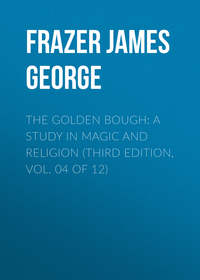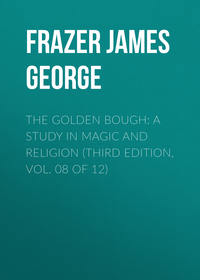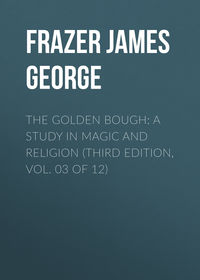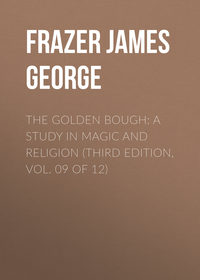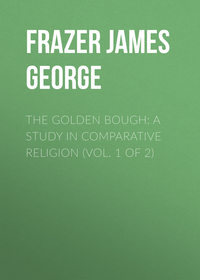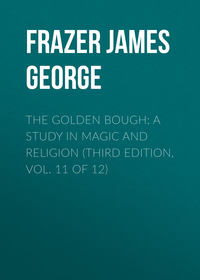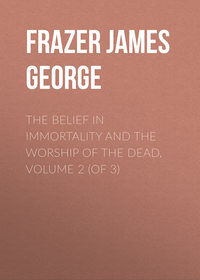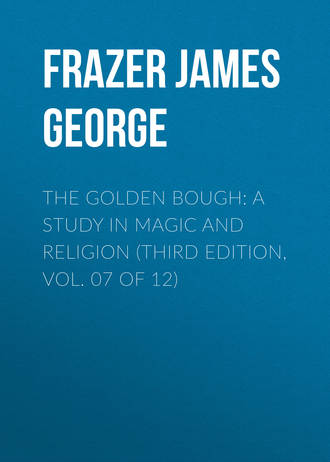 полная версия
полная версияThe Golden Bough: A Study in Magic and Religion (Third Edition, Vol. 07 of 12)
The Yabim of German New Guinea also tell tales on purpose to obtain abundant crops.
Similarly, the Yabim, a neighbouring tribe of German New Guinea, at the entrance to Huon Gulf, tell tales for the purpose of obtaining a plentiful harvest of yams, taro, sugar-cane, and bananas.331 They subsist chiefly by the fruits of the earth which they cultivate, and among which taro, yams, and sugar-cane supply them with their staple food.332 In their agricultural labours they believe themselves to be largely dependent on the spirits of their dead, the balum, as they call them. Before they plant the first taro in a newly cleared field they invoke the souls of the dead to make the plants grow and prosper; and to propitiate these powerful spirits they bring valuable objects, such as boar's tusks and dog's teeth, into the field, in order that the ghosts may deck themselves with the souls of these ornaments, while at the same time they minister to the grosser appetites of the disembodied spirits by offering them a savoury mess of taro porridge. Later in the season they whirl bull-roarers in the fields and call out the names of the dead, believing that this makes the crops to thrive.333
Specimens of Yabim tales told as charms to procure a good harvest. Such tales may be called narrative spells.
But besides the prayers which they address to the spirits of the dead for the sake of procuring an abundant harvest, the Yabim utter spells for the same purpose, and these spells sometimes take the form, not of a command, but of a narrative. Here, for instance, is one of their spells: “Once upon a time a man laboured in his field and complained that he had no taro shoots. Then came two doves flying from Poum. They had devoured much taro, and they perched on a tree in the field, and during the night they vomited all the taro up. Thus the man got so many taro shoots that he was even able to sell some of them to other people.” Or, again, if the taro will not bud, the Yabim will have recourse to the following spell: “A muraena lay at ebb-tide on the shore. It seemed to be at its last gasp. Then the tide flowed on, and the muraena came to life again and plunged into the deep water.” This spell is pronounced over twigs of a certain tree (kalelong), while the enchanter smites the ground with them. After that the taro is sure to bud.334 Apparently the mere recitation of such simple tales is thought to produce the same effect as a direct appeal, whether in the shape of a prayer or a command, addressed to the spirits. Such incantations may be called narrative spells to distinguish them from the more familiar imperative spells, in which the enchanter expresses his wishes in the form of direct commands. Much use seems to be made of such narrative spells among the natives of this part of German New Guinea. For example, among the Bukaua, who attribute practically boundless powers to sorcerers in every department of life and nature, the spells by which these wizards attempt to work their will assume one of two forms: either they are requests made to the ancestors, or they are short narratives, addressed to nobody in particular, which the sorcerer mutters while he is performing his magical rites.335 It is true, that here the distinction is drawn between narratives and requests rather than between narratives and commands; but the difference of a request from a command, though great in theory, may be very slight in practice; so that prayer and spell, in the ordinary sense of the words, may melt into each other almost imperceptibly. Even the priest or the enchanter who utters the one may be hardly conscious of the hairbreadth that divides it from the other. In regard to narrative spells, it seems probable that they have been used much more extensively among mankind than the evidence at our disposal permits us positively to affirm; in particular we may conjecture that many ancient narratives, which we have been accustomed to treat as mere myths, used to be regularly recited in magical rites as spells for the purpose of actually producing events like those which they describe.
Use of the bull-roarer to quicken the fruits of the earth.
The use of the bull-roarer to quicken the fruits of the earth is not peculiar to the Yabim. On the other side of New Guinea the instrument is employed for the same purpose by the natives of Kiwai, an island at the mouth of the Fly River. They think that by whirling bull-roarers they produce good crops of yams, sweet potatoes, and bananas; and in accordance with this belief they call the implement “the mother of yams.”336 Similarly in Mabuiag, an island in Torres Straits, the bull-roarer is looked upon as an instrument that can be used to promote the growth of garden produce, such as yams and sweet potatoes; certain spirits were supposed to march round the gardens at night swinging bull-roarers for this purpose.337 Indeed a fertilising or prolific virtue appears to be attributed to the instrument by savages who are totally ignorant of agriculture. Thus among the Dieri of central Australia, when a young man had undergone the painful initiatory ceremony of having a number of gashes cut in his back, he used to be given a bull-roarer, whereupon it was believed that he became inspired by the spirits of the men of old, and that by whirling it, when he went in search of game before his wounds were healed, he had power to cause a good harvest of lizards, snakes, and other reptiles. On the other hand, the Dieri thought that if a woman were to see a bull-roarer that had been used at the initiatory ceremonies and to learn its secret, the tribe would ever afterwards be destitute of snakes, lizards, and other such food.338 It may very well be that a similar power to fertilise or multiply edible plants and animals has been ascribed to the bull-roarer by many other peoples who employ the implement in their mysteries.
Swinging as an agricultural charm.
Further, it is to be observed that just as the Kai of New Guinea swing to and fro on reeds suspended from the branches of trees in order to promote the growth of the crops, in like manner Lettish peasants in Russia devote their leisure to swinging in spring and early summer for the express purpose of making the flax grow as high as they swing in the air.339 And we may suspect that wherever swinging is practised as a ceremony at certain times of the year, particularly in spring and at harvest, the pastime is not so much a mere popular recreation as a magical rite designed to promote the growth of the crops.340
With these examples before us we need not hesitate to believe that Dr. Nieuwenhuis is right when he attributes a deep religious or magical significance to the games which the Kayans or Bahaus of central Borneo play at their various agricultural festivals.
Analogy of the Kayans of Borneo to the Greeks of Eleusis in the early time. The Sacred Ploughing at Eleusis.
It remains to point out how far the religious or magical practices of these primitive agricultural peoples of Borneo and New Guinea appear to illustrate by analogy the original nature of the rites of Eleusis. So far as we can recompose, from the broken fragments of tradition, a picture of the religious and political condition of the Eleusinian people in the olden time, it appears to tally fairly well with the picture which Dr. Nieuwenhuis has drawn for us of the Kayans or Bahaus at the present day in the forests of central Borneo. Here as there we see a petty agricultural community ruled by hereditary chiefs who, while they unite religious to civil authority, being bound to preside over the numerous ceremonies performed for the good of the crops,341 nevertheless lead simple patriarchal lives and are so little raised in outward dignity above their fellows that their daughters do not deem it beneath them to fetch water for the household from the village well.342 Here as there we see a people whose whole religion is dominated and coloured by the main occupation of their lives; who believe that the growth of the crops, on which they depend for their subsistence, is at the mercy of two powerful spirits, a divine husband and his wife, dwelling in a subterranean world; and who accordingly offer sacrifices and perform ceremonies in order to ensure the favour of these mighty beings and so to obtain abundant harvests. If we knew more about the Rarian plain at Eleusis,343 we might discover that it was the scene of many religious ceremonies like those which are performed on the little consecrated rice-fields (the luma lali) of the Kayans, where the various operations of the agricultural year are performed in miniature by members of the chief's family before the corresponding operations may be performed on a larger scale by common folk on their fields. Certainly we know that the Rarian plain witnessed one such ceremony in the year. It was a solemn ceremony of ploughing, one of the three Sacred Ploughings which took place annually in various parts of Attica.344 Probably the rite formed part of the Proerosia or Festival before Ploughing, which was intended to ensure a plentiful crop.345 Further, it appears that the priests who guided the sacred slow-paced oxen as they dragged the plough down the furrows of the Rarian Plain, were drawn from the old priestly family of Bouzygai or “Ox-yokers,” whose eponymous ancestor is said to have been the first man to yoke oxen and to plough the fields. As they performed this time-honoured ceremony, the priests uttered many quaint curses against all churls who should refuse to lend fire or water to neighbours, or to shew the way to wanderers, or who should leave a corpse unburied.346 If we had a complete list of the execrations fulminated by the holy ploughmen on these occasions, we might find that some of them were levelled at the impious wretches who failed to keep all the rules of the Sabbath, as we may call those periods of enforced rest and seclusion which the Kayans of Borneo and other primitive agricultural peoples observe for the good of the crops.347
The connexion of the Eleusinian games with agriculture, attested by the ancients, is confirmed by modern savage analogies.
Further, when we see that many primitive peoples practise what we call games but what they regard in all seriousness as solemn rites for the good of the crops, we may be the more inclined to accept the view of the ancients, who associated the Eleusinian games directly with the worship of Demeter and Persephone, the Corn Goddesses.348 One of the contests at the Eleusinian games was in leaping,349 and we know that even in modern Europe to this day leaping or dancing high is practised as a charm to make the crops grow tall.350 Again, the bull-roarer was swung so as to produce a humming sound at the Greek mysteries;351 and when we find the same simple instrument whirled by savages in New Guinea for the sake of ensuring good crops, we may reasonably conjecture that it was whirled with a like intention by the rude forefathers of the Greeks among the cornfields of Eleusis. If that were so – though the conjecture is hardly susceptible of demonstration – it would go some way to confirm the theory that the Eleusinian mysteries were in their origin nothing more than simple rustic ceremonies designed to make the farmer's fields to wave with yellow corn. And in the practice of the Kayans, whose worship of the rice offers many analogies to the Eleusinian worship of the corn, may we not detect a hint of the origin of that rule of secrecy which always characterised the Eleusinian mysteries? May it not have been that, just as the Kayans exclude strangers from their villages while they are engaged in the celebration of religious rites, lest the presence of these intruders should frighten or annoy the shy and touchy spirits who are invoked at these times, so the old Eleusinians may have debarred foreigners from participation in their most solemn ceremonies, lest the coy goddesses of the corn should take fright or offence at the sight of strange faces and so refuse to bestow on men their annual blessing? The admission of foreigners to the privilege of initiation in the mysteries was probably a late innovation introduced at a time when the fame of their sanctity had spread far and wide, and when the old magical meaning of the ritual had long been obscured, if not forgotten.
The sacred drama of the Eleusinian mysteries compared to the masked dances of agricultural savages.
Lastly, it may be suggested that in the masked dances and dramatic performances, which form a conspicuous and popular feature of the Sowing Festival among the Kayans,352 we have the savage counterpart of that drama of divine death and resurrection which appears to have figured so prominently in the mysteries of Eleusis.353 If my interpretation of that solemn drama is correct, it represented in mythical guise the various stages in the growth of the corn for the purpose of magically fostering the natural processes which it simulated. In like manner among the Kaua and Kobeua Indians of North-western Brazil, who subsist chiefly by the cultivation of manioc, dances or rather pantomimes are performed by masked men, who represent spirits or demons of fertility, and by imitating the act of procreation are believed to stimulate the growth of plants as well as to quicken the wombs of women and to promote the multiplication of animals. Coarse and grotesque as these dramatic performances may seem to us, they convey no suggestion of indecency to the minds either of the actors or of the spectators, who regard them in all seriousness as rites destined to confer the blessing of fruitfulness on the inhabitants of the village, on their plantations, and on the whole realm of nature.354 However, we possess so little exact information as to the rites of Eleusis that all attempts to elucidate them by the ritual of savages must necessarily be conjectural. Yet the candid reader may be willing to grant that conjectures supported by analogies like the foregoing do not exceed the limits of a reasonable hypothesis.
Chapter IV. Woman's Part in Primitive Agriculture
Theory that the personification of corn as feminine was suggested by the part played by women in primitive agriculture.
If Demeter was indeed a personification of the corn, it is natural to ask, why did the Greeks personify the corn as a goddess rather than a god? why did they ascribe the origin of agriculture to a female rather than to a male power? They conceived the spirit of the vine as masculine; why did they conceive the spirit of the barley and wheat as feminine? To this it has been answered that the personification of the corn as feminine, or at all events the ascription of the discovery of agriculture to a goddess, was suggested by the prominent part which women take in primitive agriculture.355 The theory illustrates a recent tendency of mythologists to explain many myths as reflections of primitive society rather than as personifications of nature. For that reason, apart from its intrinsic interest, the theory deserves to be briefly considered.
Among many savage tribes the labour of hoeing the ground and sowing the seed devolves on women. Agricultural work done by women among the Zulus and other tribes of South Africa.
Before the invention of the plough, which can hardly be worked without resort to the labour of men, it was and still is customary in many parts of the world to break up the soil for cultivation with hoes, and among not a few savage peoples to this day the task of hoeing the ground and sowing the seed devolves mainly or entirely upon the women, while the men take little or no part in cultivation beyond clearing the land by felling the forest trees and burning the fallen timber and brushwood which encumber the soil. Thus, for example, among the Zulus, “when a piece of land has been selected for cultivation, the task of clearing it belongs to the men. If the ground be much encumbered, this becomes a laborious undertaking, for their axe is very small, and when a large tree has to be encountered, they can only lop the branches; fire is employed when it is needful to remove the trunk. The reader will therefore not be surprised that the people usually avoid bush-land, though they seem to be aware of its superior fertility. As a general rule the men take no further share in the labour of cultivation; and, as the site chosen is seldom much encumbered and frequently bears nothing but grass, their part of the work is very slight. The women are the real labourers; for (except in some particular cases) the entire business of digging, planting, and weeding devolves on them; and, if we regard the assagai and shield as symbolical of the man, the hoe may be looked upon as emblematic of the woman… With this rude and heavy instrument the woman digs, plants, and weeds her garden. Digging and sowing are generally one operation, which is thus performed; the seed is first scattered on the ground, when the soil is dug or picked up with the hoe, to the depth of three or four inches, the larger roots and tufts of grass being gathered out, but all the rest left in or on the ground.”356 A special term of contempt is applied to any Zulu man, who, deprived of the services of his wife and family, is compelled by hard necessity to handle the hoe himself.357 Similarly among the Baronga of Delagoa Bay, “when the rains begin to fall, sometimes as early as September but generally later, they hasten to sow. With her hoe in her hands, the mistress of the field walks with little steps; every time she lifts a clod of earth well broken up, and in the hole thus made she plants three or four grains of maize and covers them up. If she has not finished clearing all the patch of the bush which she contemplated, she proceeds to turn up again the fields she tilled last year. The crop will be less abundant than in virgin soil, but they plant three or four years successively in the same field before it is exhausted. As for enriching the soil with manure, they never think of it.”358 Among the Barotsé, who cultivate millet, maize, and peas to a small extent and in a rudimentary fashion, women alone are occupied with the field-work, and their only implement is a spade or hoe.359 Of the Matabelé we are told that “most of the hard work is performed by the women; the whole of the cultivation is done by them. They plough with short spades of native manufacture; they sow the fields, and they clear them of weeds.”360 Among the Awemba, to the west of Lake Tanganyika, the bulk of the work in the plantations falls on the women; in particular the men refuse to hoe the ground. They have a saying, “Is not each male child born for the axe and each female child for the hoe?”361
Chastity required in the sowers of seed.
The natives of the Tanganyika plateau “cultivate the banana, and have a curious custom connected with it. No man is permitted to sow; but when the hole is prepared a little girl is carried to the spot on a man's shoulders. She first throws into the hole a sherd of broken pottery, and then scatters the seed over it.”362 The reason of the latter practice has been explained by more recent observers of these natives. “Young children, it may here be noted, are often employed to administer drugs, remedies, even the Poison Ordeal, and to sow the first seeds. Such acts, the natives say, must be performed by chaste and innocent hands, lest a contaminated touch should destroy the potency of the medicine or of the seedlings planted. It used to be a very common sight upon the islands of Lake Bangweolo to watch how a Bisa woman would solve the problem of her own moral unfitness by carrying her baby-girl to the banana-plot, and inserting seedlings in the tiny hands for dropping into the holes already prepared.”363 Similarly among the people of the Lower Congo “women must remain chaste while planting pumpkin and calabash seeds, they are not allowed to touch any pig-meat, and they must wash their hands before touching the seeds. If a woman does not observe all these rules, she must not plant the seeds, or the crop will be bad; she may make the holes, and her baby girl, or another who has obeyed the restrictions, can drop in the seeds and cover them over.”364 We can now perhaps understand why Attic matrons had to observe strict chastity when they celebrated the festival of the Thesmophoria.365 In Attica that festival was held in honour of Demeter in the month of Pyanepsion, corresponding to October,366 the season of the autumn sowing; and the rites included certain ceremonies which bore directly on the quickening of the seed.367 We may conjecture that the rule of chastity imposed on matrons at this festival was a relic of a time when they too, like many savage women down to the present time, discharged the important duty of sowing the seed and were bound for that reason to observe strict continence, lest any impurity on their part should defile the seed and prevent it from bearing fruit.
Woman's part in agriculture among the Caffres of South Africa in general.
Of the Caffres of South Africa in general we read that “agriculture is mainly the work of the women, for in olden days the men were occupied in hunting and fighting. The women do but scratch the land with hoes, sometimes using long-handled instruments, as in Zululand, and sometimes short-handled ones, as above the Zambesi. When the ground is thus prepared, the women scatter the seed, throwing it over the soil quite at random. They know the time to sow by the position of the constellations, chiefly by that of the Pleiades. They date their new year from the time they can see this constellation just before sunrise.”368 In Basutoland, where the women also till the fields, though the lands of chiefs are dug and sowed by men, an attempt is made to determine the time of sowing by observation of the moon, but the people generally find themselves out in their reckoning, and after much dispute are forced to fall back upon the state of the weather and of vegetation as better evidence of the season of sowing. Intelligent chiefs rectify the calendar at the summer solstice, which they call the summer-house of the sun.369
Agricultural work done by women among the Nandi, Baganda, the Congo, and other tribes of Central and Western Africa.
Among the Nandi of British East Africa “the rough work of clearing the bush for plantations is performed by the men, after which nearly all work in connexion with them is done by the women. The men, however, assist in sowing the seed, and in harvesting some of the crops. As a rule trees are not felled, but the bark is stripped off for about four feet from the ground and the trees are then left to die. The planting is mostly, if not entirely, done during the first half of the Kiptamo moon (February), which is the first month of the year, and when the Iwat-kut moon rises (March) all seed should be in the ground. The chief medicine man is consulted before the planting operations begin, but the Nandi know by the arrival in the fields of the guinea-fowl, whose song is supposed to be, O-kol, o-kol; mi-i tokoch (Plant, plant; there is luck in it), that the planting season is at hand. When the first seed is sown, salt is mixed with it, and the sower sings mournfully: Ak o-siek-u o-chok-chi (And grow quickly), as he sows. After fresh ground has been cleared, eleusine grain is planted. This crop is generally repeated the second year, after which millet is sown, and finally sweet potatoes or some other product. Most fields are allowed to lie fallow every fourth or fifth year. The Nandi manure their plantations with turf ashes… The eleusine crops are harvested by both men and women. All other crops are reaped by the women only, who are at times assisted by the children. The corn is pounded and winnowed by the women and girls.”370 Among the Suk and En-jemusi of British East Africa it is the women who cultivate the fields and milk the cows.371 Among the Wadowe of German East Africa the men clear the forest and break up the hard ground, but the women sow and reap the crops.372 So among the Wanyamwezi, who are an essentially agricultural people, to the south of Lake Victoria Nyanza, the men cut down the bush and hoe the hard ground, but leave the rest of the labour of weeding, sowing, and reaping to the women.373 The Baganda of Central Africa subsist chiefly on bananas, and among them “the garden and its cultivation have always been the woman's department. Princesses and peasant women alike looked upon cultivation as their special work; the garden with its produce was essentially the wife's domain, and she would under no circumstances allow her husband to do any digging or sowing in it. No woman would remain with a man who did not give her a garden and a hoe to dig it with; if these were denied her, she would seek an early opportunity to escape from her husband and return to her relations to complain of her treatment, and to obtain justice or a divorce. When a man married he sought a plot of land for his wife in order that she might settle to work and provide food for the household… In initial clearing of the land it was customary for the husband to take part; he cut down the tall grass and shrubs, and so left the ground ready for his wife to begin her digging. The grass and the trees she heaped up and burned, reserving only so much as she needed for firewood. A hoe was the only implement used in cultivation; the blade was heart-shaped with a prong at the base, by which it was fastened to the handle. The hoe-handle was never more than two feet long, so that a woman had to stoop when using it.”374 In Kiziba, a district immediately to the south of Uganda, the tilling of the soil is exclusively the work of the women. They turn up the soil with hoes, make holes in the ground with digging-sticks or their fingers, and drop a few seeds into each hole.375 Among the Niam-Niam of Central Africa “the men most studiously devote themselves to their hunting, and leave the culture of the soil to be carried on exclusively by the women”;376 and among the Monbuttoo of the same region in like manner, “whilst the women attend to the tillage of the soil and the gathering of the harvest, the men, unless they are absent either for war or hunting, spend the entire day in idleness.”377 As to the Bangala of the Upper Congo we read that “large farms were made around the towns. The men did the clearing of the bush, felling the trees, and cutting down the undergrowth; the women worked with them, heaping up the grass and brushwood ready for burning, and helping generally. As a rule the women did the hoeing, planting, and weeding, but the men did not so despise this work as never to do it.” In this tribe “the food belonged to the woman who cultivated the farm, and while she supplied her husband with the vegetable food, he had to supply the fish and meat and share them with his wife or wives.”378 Amongst the Tofoke, a tribe of the Congo State on the equator, all the field labour, except the clearing away of the forest, is performed by the women. They dig the soil with a hoe and plant maize and manioc. A field is used only once.379 So with the Ba-Mbala, a Bantu tribe between the rivers Inzia and Kwilu, the men clear the ground for cultivation, but all the rest of the work of tillage falls to the women, whose only tool is an iron hoe. Fresh ground is cleared for cultivation every year.380 The Mpongwe of the Gaboon, in West Africa, cultivate manioc (cassava), maize, yams, plantains, sweet potatoes, and ground nuts. When new clearings have to be made in the forest, the men cut down and burn the trees, and the women put in the crop. The only tool they use is a dibble, with which they turn up a sod, put in a seed, and cover it over.381 Among the Ashira of the same region the cultivation of the soil is in the hands of the women.382




